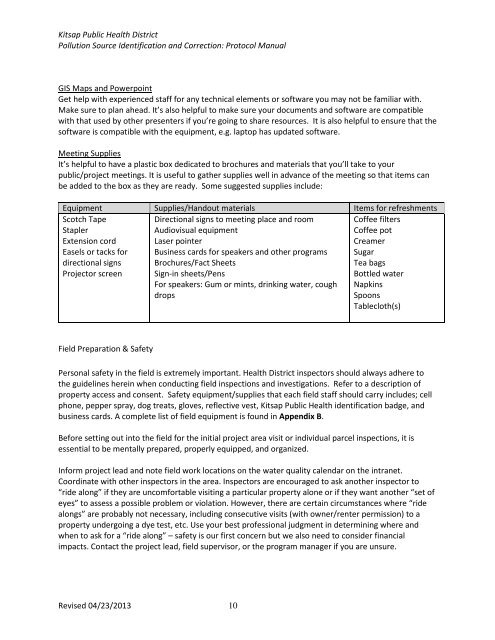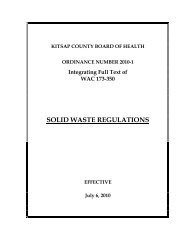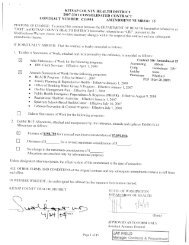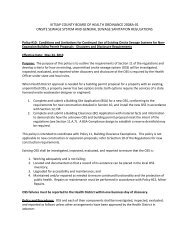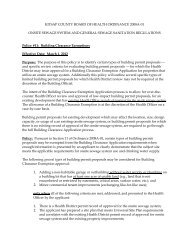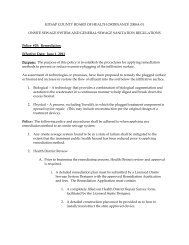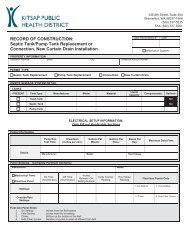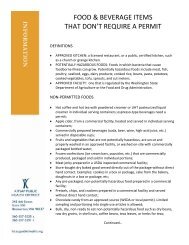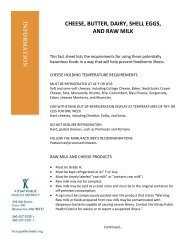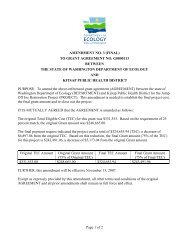(PIC) Protocol Manual - Kitsap Public Health District
(PIC) Protocol Manual - Kitsap Public Health District
(PIC) Protocol Manual - Kitsap Public Health District
You also want an ePaper? Increase the reach of your titles
YUMPU automatically turns print PDFs into web optimized ePapers that Google loves.
<strong>Kitsap</strong> <strong>Public</strong> <strong>Health</strong> <strong>District</strong><br />
Pollution Source Identification and Correction: <strong>Protocol</strong> <strong>Manual</strong><br />
GIS Maps and Powerpoint<br />
Get help with experienced staff for any technical elements or software you may not be familiar with.<br />
Make sure to plan ahead. It’s also helpful to make sure your documents and software are compatible<br />
with that used by other presenters if you’re going to share resources. It is also helpful to ensure that the<br />
software is compatible with the equipment, e.g. laptop has updated software.<br />
Meeting Supplies<br />
It’s helpful to have a plastic box dedicated to brochures and materials that you’ll take to your<br />
public/project meetings. It is useful to gather supplies well in advance of the meeting so that items can<br />
be added to the box as they are ready. Some suggested supplies include:<br />
Equipment Supplies/Handout materials Items for refreshments<br />
Scotch Tape<br />
Stapler<br />
Extension cord<br />
Easels or tacks for<br />
directional signs<br />
Projector screen<br />
Directional signs to meeting place and room<br />
Audiovisual equipment<br />
Laser pointer<br />
Business cards for speakers and other programs<br />
Brochures/Fact Sheets<br />
Sign-in sheets/Pens<br />
For speakers: Gum or mints, drinking water, cough<br />
drops<br />
Coffee filters<br />
Coffee pot<br />
Creamer<br />
Sugar<br />
Tea bags<br />
Bottled water<br />
Napkins<br />
Spoons<br />
Tablecloth(s)<br />
Field Preparation & Safety<br />
Personal safety in the field is extremely important. <strong>Health</strong> <strong>District</strong> inspectors should always adhere to<br />
the guidelines herein when conducting field inspections and investigations. Refer to a description of<br />
property access and consent. Safety equipment/supplies that each field staff should carry includes; cell<br />
phone, pepper spray, dog treats, gloves, reflective vest, <strong>Kitsap</strong> <strong>Public</strong> <strong>Health</strong> identification badge, and<br />
business cards. A complete list of field equipment is found in Appendix B.<br />
Before setting out into the field for the initial project area visit or individual parcel inspections, it is<br />
essential to be mentally prepared, properly equipped, and organized.<br />
Inform project lead and note field work locations on the water quality calendar on the intranet.<br />
Coordinate with other inspectors in the area. Inspectors are encouraged to ask another inspector to<br />
“ride along” if they are uncomfortable visiting a particular property alone or if they want another “set of<br />
eyes” to assess a possible problem or violation. However, there are certain circumstances where “ride<br />
alongs” are probably not necessary, including consecutive visits (with owner/renter permission) to a<br />
property undergoing a dye test, etc. Use your best professional judgment in determining where and<br />
when to ask for a “ride along” – safety is our first concern but we also need to consider financial<br />
impacts. Contact the project lead, field supervisor, or the program manager if you are unsure.<br />
Revised 04/23/2013 10


